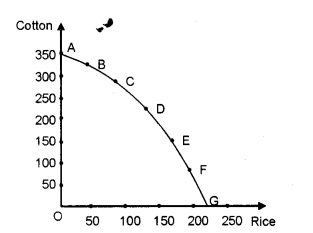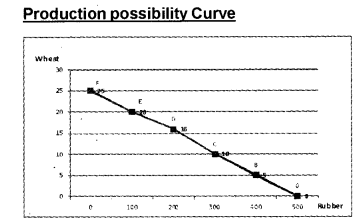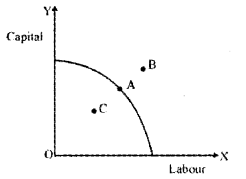Kerala Plus Two Microeconomics Chapter Wise Previous Questions Chapter 1 Introduction to Microeconomics
Question 1.
How each of the following affects the Production Possibility Curve of an Economy? (MARCH – 2008)
a) The number of employed workers increase.
b) Tsunami destroys some production facilities.
c) Introduction of capital intensive technique.
d) Increase in fuel price.
Answer:
PPC shifts outward
b) PPC shifts inwards
c) PPC shifts outwards
d) PPC shifts inwards
Question 2.
Below is given a Production Possibility Schedule (MARCH – 2008)

a) Draw the Production Possibility Curve.
b) Prepare the Marginal Opportunity cost in a table based o the PPC.
Answer:
a)

b)
| Cotton | Rice | MOC |
| 350 | 0 | – |
| 300 | 50 | 50 |
| 250 | 75 | 25 |
| 170 | 120 | 45 |
| 100 | 150 | 30 |
| 50 | 180 | 30 |
Question 3.
Micro Economics is otherwise known as “price theory”. Do you agree with this statement? Justify your answer. (MARCH – 2009)
Answer:
Yes.
It is related to the theory of product and factor pricing.
Question 4.
Some Economic Variables are given below. Classify them in a table based on two branches of Economics. Give suitable titles to the column.
General price level, Aggregate consumption,Rent for a house in a city, Demand forfish in a local market. (MARCH – 2009)
Answer:
| Micro | Macro |
| Rent for a house in a city | General price level |
| Demand for fish in a local market | Aggregate consumption |
Question 5.
A production possibility schedule is given below (MAY-2010)

a) Calculate M.O.C
b) What is the shape of PPC?
Answer:
a)

b) downward slope
Question 6.
Complete the following table : (MARCH-2012)
| Features of centrally planned economy | Features of market economy |
| 1. | 1. |
| 2. | 2. |
Answer:
| Features of centrally planned economy | Features of market economy |
| 1. Comprehensive planning | 1. Price mechanism |
| 2. Public sector | 2. Profit motive |
| 3. Public Welfare | 3. Private sector |
Question 7.
Mention one example for each of the following market structures. (MARCH-2013)
i) Monopoly
ii) Monopolistic competition
Answer:
i) monopoly – Indian railway
ii) monopolistic competition – tooth paste
Question 8.
In a centrally planned economy all important decisions regarding production, exchange and consumption are taken by (MARCH-2014)
a) The Government
b) The Market
c) Either of (a) and (b)
d) The Central Bank
Answer:
The Government
Question 9.
Among the three statements given, which statement is a normative statement? (MAY-2014)
a) People work hard if wages are high.
b) The unemployment rate should be lower
c) Printing too much of money causes inflation.
Answer:
a) people work hard if wages are high.
Question 10.
Who is known as the father of modern Macro Economics? (MARCH-2015)
a) Adam Smith
b) Alfred Marshall
c) J.M.Keynes
d) J.B.Say
Answer:
c) J.M.Keynes
Question 11.
Prepare a production possibility Schedule and draw a production possibility curve on the basis of the schedule, how do you define the PPC? (MAY-2015)
Answer:
Production possibility curve is the locus of combinations of two goods that can be produced when the resources of the economy are fully utilized. Given below a production possible schedule and a production possibility curve.
| Production possibilities | Wheat | Rubber |
| A | 0 | 500 |
| B | 5 | 400 |
| C | 10 | 300 |
| D | 15 | 200 |
| E | 20 | 100 |
| F | 25 | 0 |

Question 12.
The choice of technology is associated with (MARCH-2016)
a) What to produce?
b) Howto produce?
c) For whom to produce
d) None of these
Answer:
b) How to produce
Question 13.
Central problems faced by an economy can be solved through different ways by different economic systems. (MAY-2016)
a) Which are the important economic systems?
b) How each system solves the central problems?
Answer:
a) Economic systems are:
i) Capitalism
ii) Socialism
iii) Mixed economy
b) Solution of central problems
i) Capitalist economy solves the central economic problems through price mechanism
ii) Socialist economy solves the central economic problems through economic planning.
iii) Mixed economy solves the central economic problems through both price mechanism and central planning.
Question 14.
Identify the curve given below. What does the points A, B, C represents? (MARCH-2017)

Answer:
Production Possibility Curve: It shows various combinations of two goods that an economy can produce with a given level of resources and a given level of technology.
Point ‘A’shows efficient utilisation of resources. Point ‘B’ We can say that at any point above the existing PPC shows the growth of resources and Point ‘C’ inside the production possibility curve implies insufficient utilisation of resources.
Question 15.
Which among the following is not a characteristics of a Capitalist Economy? (MARCH-2017)
a) Wages and prices are administered by the government.
b) Private ownership of means of production.
c) Production takes place for exchange
d) Sale and purchase of labour services at a price is called wage rate.
Answer:
Wages and prices are administered by the government.
